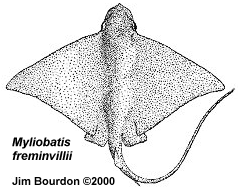| |

 The eagle rays are found circumglobally in warm-temperate and tropical continental seas. The lozenge-shaped disc is broader (exceeding 1.25 m) than long and mostly smooth. Small patches of dermal denticles may be present above the eyes, along the spine and in males, on the shoulder region. The tail is longer than the body and bears one or two caudal spines. Eagle rays are found over muddy & sandy bottoms of coastal waters, bays & estuaries. Depending on species, they feed on shrimps, crabs, bivalves, gastropods, polychaetes and occasionally, fish. They use the pectorals to help excavate prey and a grinding dentition to feed. These rays have been known to bury in mud and travel in schools.
The eagle rays are found circumglobally in warm-temperate and tropical continental seas. The lozenge-shaped disc is broader (exceeding 1.25 m) than long and mostly smooth. Small patches of dermal denticles may be present above the eyes, along the spine and in males, on the shoulder region. The tail is longer than the body and bears one or two caudal spines. Eagle rays are found over muddy & sandy bottoms of coastal waters, bays & estuaries. Depending on species, they feed on shrimps, crabs, bivalves, gastropods, polychaetes and occasionally, fish. They use the pectorals to help excavate prey and a grinding dentition to feed. These rays have been known to bury in mud and travel in schools.
Compagno (1999) recognized 12 extant species. These included:
Myliobatis aquila (LINNAEUS, 1758) - Common eagle ray. A medium-sized (1.8 m DW), subtropical ray of the Eastern Atlantic, known from the British Isles & southwestern North Sea, to the Mediterranean, North Africa & Canaries and South Africa. They are found in shallow lagoons, bays and estuaries but also offshore (to 95 m).
M. californica GILL, 1865 - Bat (eagle) ray. A common, medium-sized (1.8 m DW), subtropical ray of the Eastern Pacific from Oregon to Gulf of California and the Galapagos Islands.
M. freminvillii LESUEUR, 1824 - Bullnose (eagle) ray. A small (<1 m DW) common subtropical ray of the Western Atlantic's coastal waters (to 10 m depth). Known from Cape Cod to Florida and northern South America (possibly from Gulf of Mexico & Caribbean).
M. goodei GARMAN, 1885 - Southern eagle ray. A small (<1 m DW), poorly known, tropical ray of the Western Atlantic and Caribbean. Known from South Carolina to Argentina.
Dentition
 The dental configuration usually includes a single elongated medial file and three lateral files of teeth on each side (refer to figure 2). When viewed laterally, the lower tooth plate is relatively flat and the upper, convex. Bigelow & Schroeder (1953) note that the width:depth ratio of the medial teeth vary by position and age. They note that in juveniles, the upper tooth ratio is 3.5:1 and the lower, 2.5:1. In adults, this ratio is 5:1 in both uppers and lowers. They go on to note that the number of functional teeth are equally variable. Juveniles have 4 upper and 6 lower functional rows, while in adults, it's 6/12-13. The teeth of the figured Myliobatis californica are clearly hexagonal in non-termino-lateral positions. Laminae of the relatively low root extend lingually beyond the lingual margin of the crown. The labial and lingual crown faces are erect and a strong lingual shelf is present.
The dental configuration usually includes a single elongated medial file and three lateral files of teeth on each side (refer to figure 2). When viewed laterally, the lower tooth plate is relatively flat and the upper, convex. Bigelow & Schroeder (1953) note that the width:depth ratio of the medial teeth vary by position and age. They note that in juveniles, the upper tooth ratio is 3.5:1 and the lower, 2.5:1. In adults, this ratio is 5:1 in both uppers and lowers. They go on to note that the number of functional teeth are equally variable. Juveniles have 4 upper and 6 lower functional rows, while in adults, it's 6/12-13. The teeth of the figured Myliobatis californica are clearly hexagonal in non-termino-lateral positions. Laminae of the relatively low root extend lingually beyond the lingual margin of the crown. The labial and lingual crown faces are erect and a strong lingual shelf is present.
|